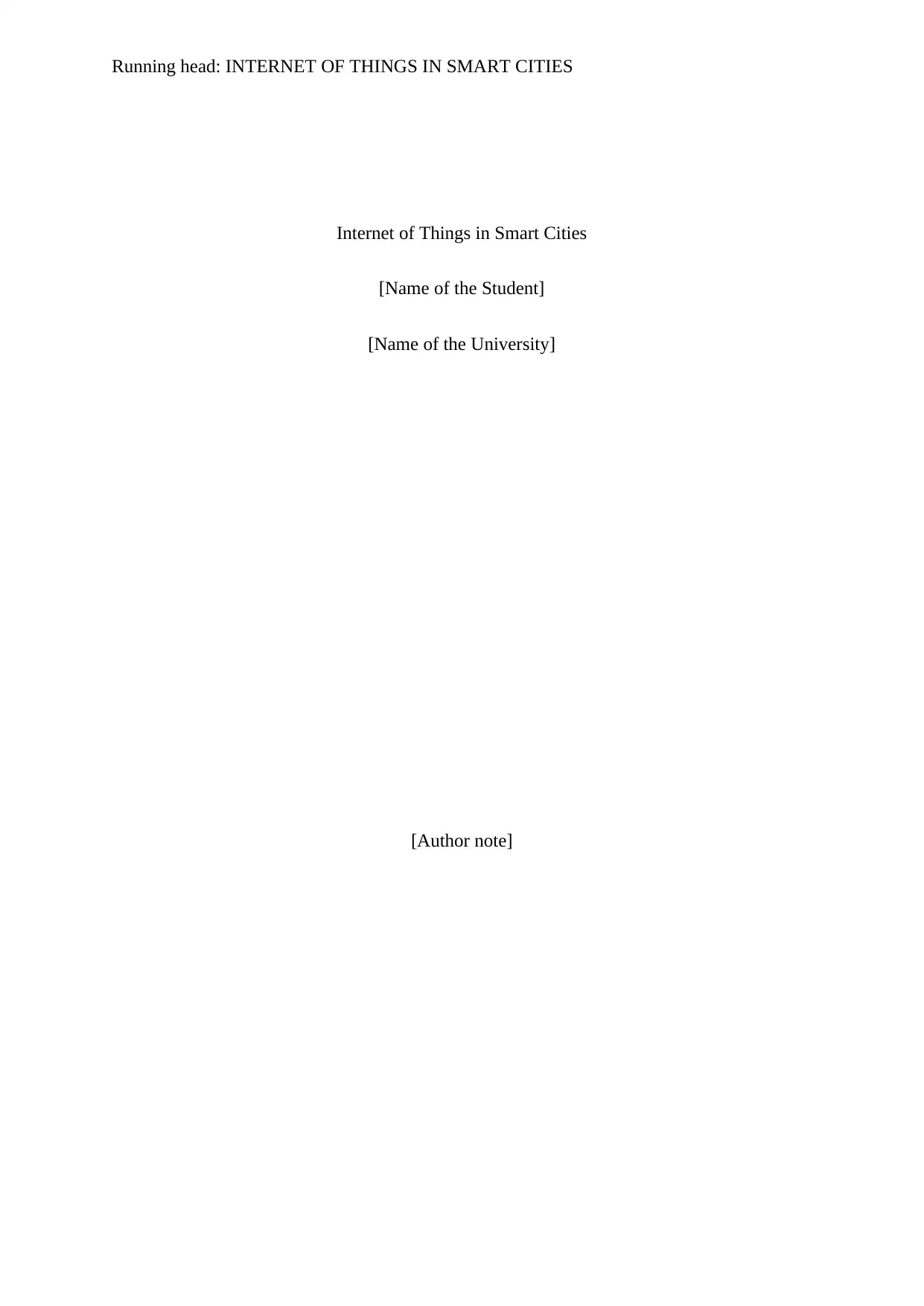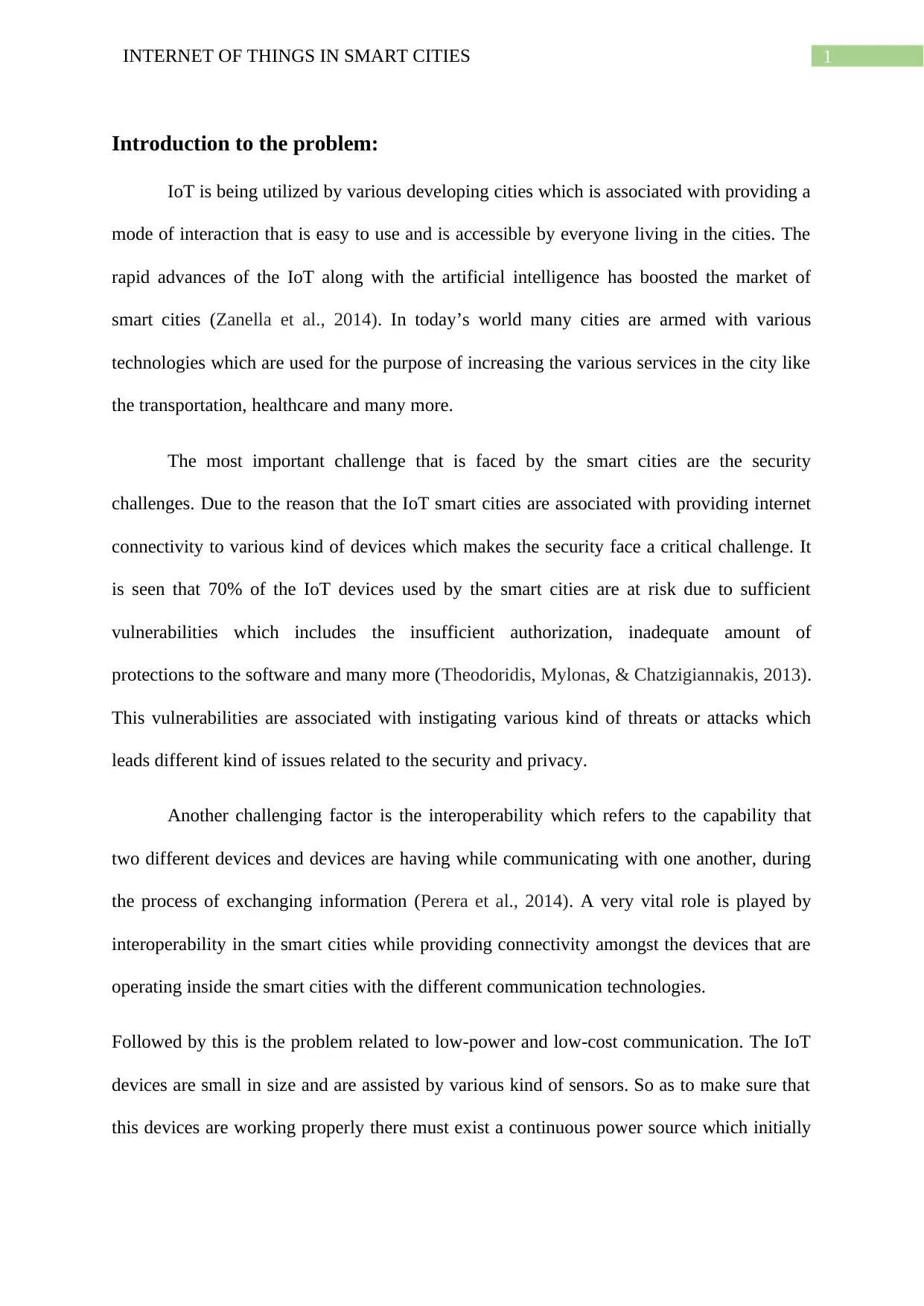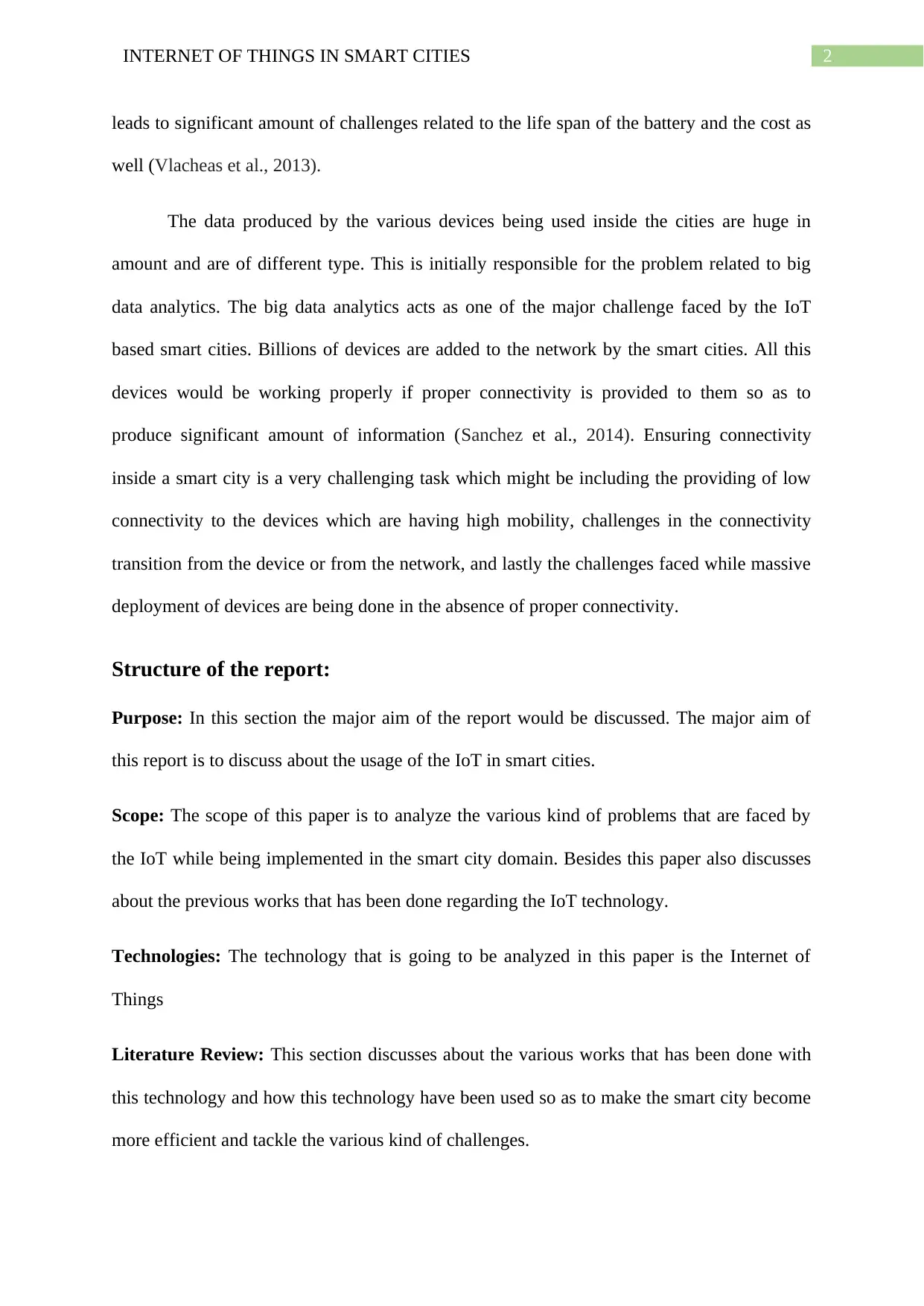ITC560: Internet of Things Applications and Challenges in Smart Cities
VerifiedAdded on 2023/06/07
|5
|1122
|351
Report
AI Summary
This report discusses the utilization of the Internet of Things (IoT) in developing smart cities, highlighting its role in providing accessible interaction and boosting the smart city market through advancements in artificial intelligence. It identifies key challenges such as security vulnerabilities in IoT devices, interoperability issues among diverse communication technologies, and the need for low-power, low-cost communication solutions. The report also addresses the problem of big data analytics due to the massive amounts of data generated by IoT devices, and the difficulties in ensuring connectivity for devices with high mobility. The structure of the report includes a literature review, annotated bibliography, research findings, and recommendations to enhance the efficiency of IoT in smart cities. It concludes by summarizing the problems, previous works, selected methodologies, and recommendations for future research.

Running head: INTERNET OF THINGS IN SMART CITIES
Internet of Things in Smart Cities
[Name of the Student]
[Name of the University]
[Author note]
Internet of Things in Smart Cities
[Name of the Student]
[Name of the University]
[Author note]
Paraphrase This Document
Need a fresh take? Get an instant paraphrase of this document with our AI Paraphraser

1INTERNET OF THINGS IN SMART CITIES
Introduction to the problem:
IoT is being utilized by various developing cities which is associated with providing a
mode of interaction that is easy to use and is accessible by everyone living in the cities. The
rapid advances of the IoT along with the artificial intelligence has boosted the market of
smart cities (Zanella et al., 2014). In today’s world many cities are armed with various
technologies which are used for the purpose of increasing the various services in the city like
the transportation, healthcare and many more.
The most important challenge that is faced by the smart cities are the security
challenges. Due to the reason that the IoT smart cities are associated with providing internet
connectivity to various kind of devices which makes the security face a critical challenge. It
is seen that 70% of the IoT devices used by the smart cities are at risk due to sufficient
vulnerabilities which includes the insufficient authorization, inadequate amount of
protections to the software and many more (Theodoridis, Mylonas, & Chatzigiannakis, 2013).
This vulnerabilities are associated with instigating various kind of threats or attacks which
leads different kind of issues related to the security and privacy.
Another challenging factor is the interoperability which refers to the capability that
two different devices and devices are having while communicating with one another, during
the process of exchanging information (Perera et al., 2014). A very vital role is played by
interoperability in the smart cities while providing connectivity amongst the devices that are
operating inside the smart cities with the different communication technologies.
Followed by this is the problem related to low-power and low-cost communication. The IoT
devices are small in size and are assisted by various kind of sensors. So as to make sure that
this devices are working properly there must exist a continuous power source which initially
Introduction to the problem:
IoT is being utilized by various developing cities which is associated with providing a
mode of interaction that is easy to use and is accessible by everyone living in the cities. The
rapid advances of the IoT along with the artificial intelligence has boosted the market of
smart cities (Zanella et al., 2014). In today’s world many cities are armed with various
technologies which are used for the purpose of increasing the various services in the city like
the transportation, healthcare and many more.
The most important challenge that is faced by the smart cities are the security
challenges. Due to the reason that the IoT smart cities are associated with providing internet
connectivity to various kind of devices which makes the security face a critical challenge. It
is seen that 70% of the IoT devices used by the smart cities are at risk due to sufficient
vulnerabilities which includes the insufficient authorization, inadequate amount of
protections to the software and many more (Theodoridis, Mylonas, & Chatzigiannakis, 2013).
This vulnerabilities are associated with instigating various kind of threats or attacks which
leads different kind of issues related to the security and privacy.
Another challenging factor is the interoperability which refers to the capability that
two different devices and devices are having while communicating with one another, during
the process of exchanging information (Perera et al., 2014). A very vital role is played by
interoperability in the smart cities while providing connectivity amongst the devices that are
operating inside the smart cities with the different communication technologies.
Followed by this is the problem related to low-power and low-cost communication. The IoT
devices are small in size and are assisted by various kind of sensors. So as to make sure that
this devices are working properly there must exist a continuous power source which initially

2INTERNET OF THINGS IN SMART CITIES
leads to significant amount of challenges related to the life span of the battery and the cost as
well (Vlacheas et al., 2013).
The data produced by the various devices being used inside the cities are huge in
amount and are of different type. This is initially responsible for the problem related to big
data analytics. The big data analytics acts as one of the major challenge faced by the IoT
based smart cities. Billions of devices are added to the network by the smart cities. All this
devices would be working properly if proper connectivity is provided to them so as to
produce significant amount of information (Sanchez et al., 2014). Ensuring connectivity
inside a smart city is a very challenging task which might be including the providing of low
connectivity to the devices which are having high mobility, challenges in the connectivity
transition from the device or from the network, and lastly the challenges faced while massive
deployment of devices are being done in the absence of proper connectivity.
Structure of the report:
Purpose: In this section the major aim of the report would be discussed. The major aim of
this report is to discuss about the usage of the IoT in smart cities.
Scope: The scope of this paper is to analyze the various kind of problems that are faced by
the IoT while being implemented in the smart city domain. Besides this paper also discusses
about the previous works that has been done regarding the IoT technology.
Technologies: The technology that is going to be analyzed in this paper is the Internet of
Things
Literature Review: This section discusses about the various works that has been done with
this technology and how this technology have been used so as to make the smart city become
more efficient and tackle the various kind of challenges.
leads to significant amount of challenges related to the life span of the battery and the cost as
well (Vlacheas et al., 2013).
The data produced by the various devices being used inside the cities are huge in
amount and are of different type. This is initially responsible for the problem related to big
data analytics. The big data analytics acts as one of the major challenge faced by the IoT
based smart cities. Billions of devices are added to the network by the smart cities. All this
devices would be working properly if proper connectivity is provided to them so as to
produce significant amount of information (Sanchez et al., 2014). Ensuring connectivity
inside a smart city is a very challenging task which might be including the providing of low
connectivity to the devices which are having high mobility, challenges in the connectivity
transition from the device or from the network, and lastly the challenges faced while massive
deployment of devices are being done in the absence of proper connectivity.
Structure of the report:
Purpose: In this section the major aim of the report would be discussed. The major aim of
this report is to discuss about the usage of the IoT in smart cities.
Scope: The scope of this paper is to analyze the various kind of problems that are faced by
the IoT while being implemented in the smart city domain. Besides this paper also discusses
about the previous works that has been done regarding the IoT technology.
Technologies: The technology that is going to be analyzed in this paper is the Internet of
Things
Literature Review: This section discusses about the various works that has been done with
this technology and how this technology have been used so as to make the smart city become
more efficient and tackle the various kind of challenges.
⊘ This is a preview!⊘
Do you want full access?
Subscribe today to unlock all pages.

Trusted by 1+ million students worldwide

3INTERNET OF THINGS IN SMART CITIES
Annotated Bibliography: in this section the major understandings of the literature review is
provided. This is mainly done so as to proceed with the further research regarding this
technology.
Research Findings: In this section of the paper the most appropriate methodology is selected
so as to eliminate the various kind of problems and make the technology work in a more
efficient way.
Recommendations: This sections of the report consists of further recommendations that can
be adopted so as to make the technology become more efficient.
Conclusion: The conclusion section would be summarizing the entire paper which would be
consisting of the overview of the various problems, the previous works that has been
conducted, selection of the appropriate methodology so as to eliminate the problems and
lastly the recommendations.
Annotated Bibliography: in this section the major understandings of the literature review is
provided. This is mainly done so as to proceed with the further research regarding this
technology.
Research Findings: In this section of the paper the most appropriate methodology is selected
so as to eliminate the various kind of problems and make the technology work in a more
efficient way.
Recommendations: This sections of the report consists of further recommendations that can
be adopted so as to make the technology become more efficient.
Conclusion: The conclusion section would be summarizing the entire paper which would be
consisting of the overview of the various problems, the previous works that has been
conducted, selection of the appropriate methodology so as to eliminate the problems and
lastly the recommendations.
Paraphrase This Document
Need a fresh take? Get an instant paraphrase of this document with our AI Paraphraser

4INTERNET OF THINGS IN SMART CITIES
References:
Perera, C., Zaslavsky, A., Christen, P., & Georgakopoulos, D. (2014). Sensing as a service
model for smart cities supported by internet of things. Transactions on Emerging
Telecommunications Technologies, 25(1), 81-93.
Sanchez, L., Muñoz, L., Galache, J. A., Sotres, P., Santana, J. R., Gutierrez, V., ... &
Pfisterer, D. (2014). SmartSantander: IoT experimentation over a smart city
testbed. Computer Networks, 61, 217-238.
Theodoridis, E., Mylonas, G., & Chatzigiannakis, I. (2013, July). Developing an iot smart
city framework. In Information, intelligence, systems and applications (iisa), 2013
fourth international conference on (pp. 1-6). IEEE.
Vlacheas, P., Giaffreda, R., Stavroulaki, V., Kelaidonis, D., Foteinos, V., Poulios, G., ... &
Moessner, K. (2013). Enabling smart cities through a cognitive management
framework for the internet of things. IEEE communications magazine, 51(6), 102-
111.
Zanella, A., Bui, N., Castellani, A., Vangelista, L., & Zorzi, M. (2014). Internet of things for
smart cities. IEEE Internet of Things journal, 1(1), 22-32.
References:
Perera, C., Zaslavsky, A., Christen, P., & Georgakopoulos, D. (2014). Sensing as a service
model for smart cities supported by internet of things. Transactions on Emerging
Telecommunications Technologies, 25(1), 81-93.
Sanchez, L., Muñoz, L., Galache, J. A., Sotres, P., Santana, J. R., Gutierrez, V., ... &
Pfisterer, D. (2014). SmartSantander: IoT experimentation over a smart city
testbed. Computer Networks, 61, 217-238.
Theodoridis, E., Mylonas, G., & Chatzigiannakis, I. (2013, July). Developing an iot smart
city framework. In Information, intelligence, systems and applications (iisa), 2013
fourth international conference on (pp. 1-6). IEEE.
Vlacheas, P., Giaffreda, R., Stavroulaki, V., Kelaidonis, D., Foteinos, V., Poulios, G., ... &
Moessner, K. (2013). Enabling smart cities through a cognitive management
framework for the internet of things. IEEE communications magazine, 51(6), 102-
111.
Zanella, A., Bui, N., Castellani, A., Vangelista, L., & Zorzi, M. (2014). Internet of things for
smart cities. IEEE Internet of Things journal, 1(1), 22-32.
1 out of 5
Related Documents
Your All-in-One AI-Powered Toolkit for Academic Success.
+13062052269
info@desklib.com
Available 24*7 on WhatsApp / Email
![[object Object]](/_next/static/media/star-bottom.7253800d.svg)
Unlock your academic potential
Copyright © 2020–2025 A2Z Services. All Rights Reserved. Developed and managed by ZUCOL.




